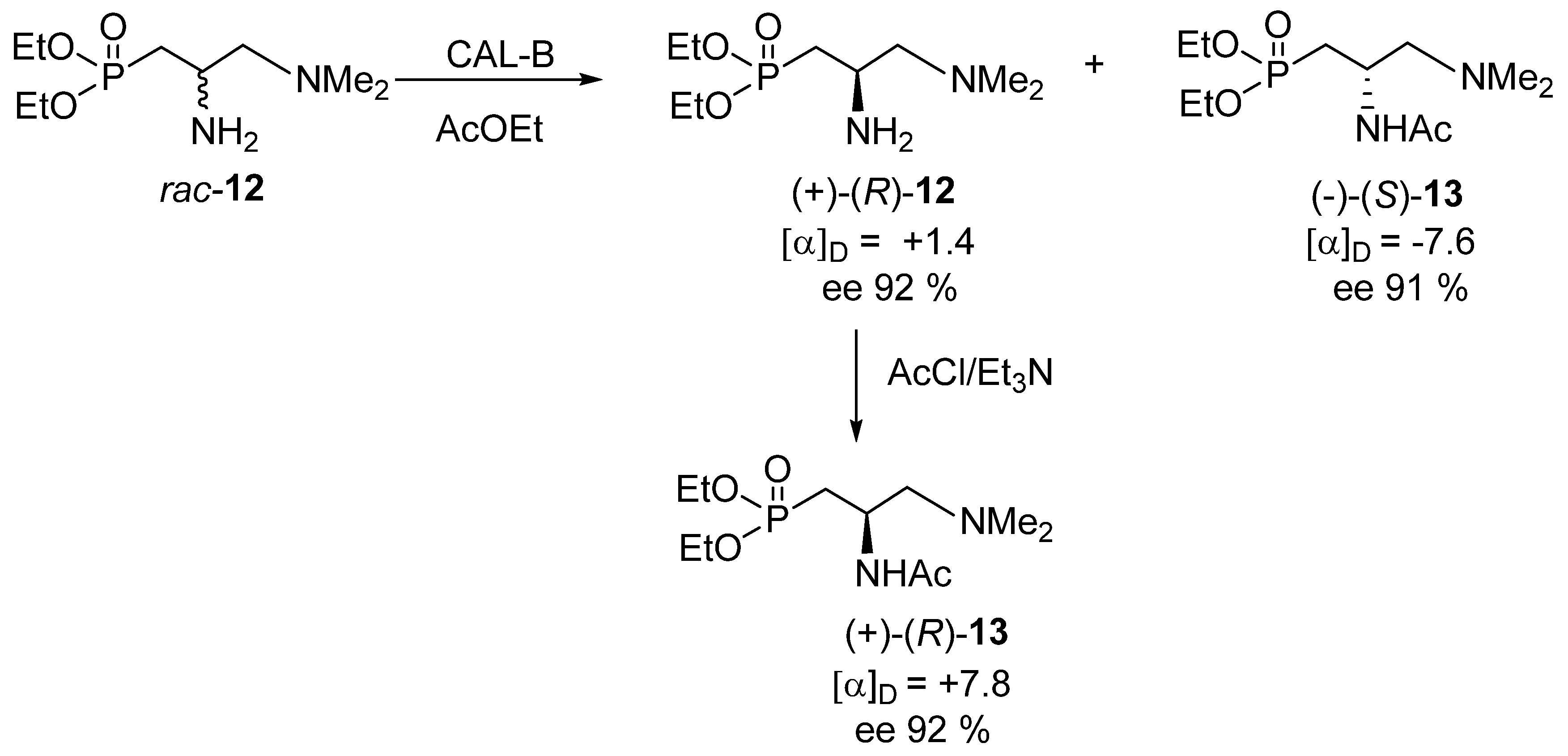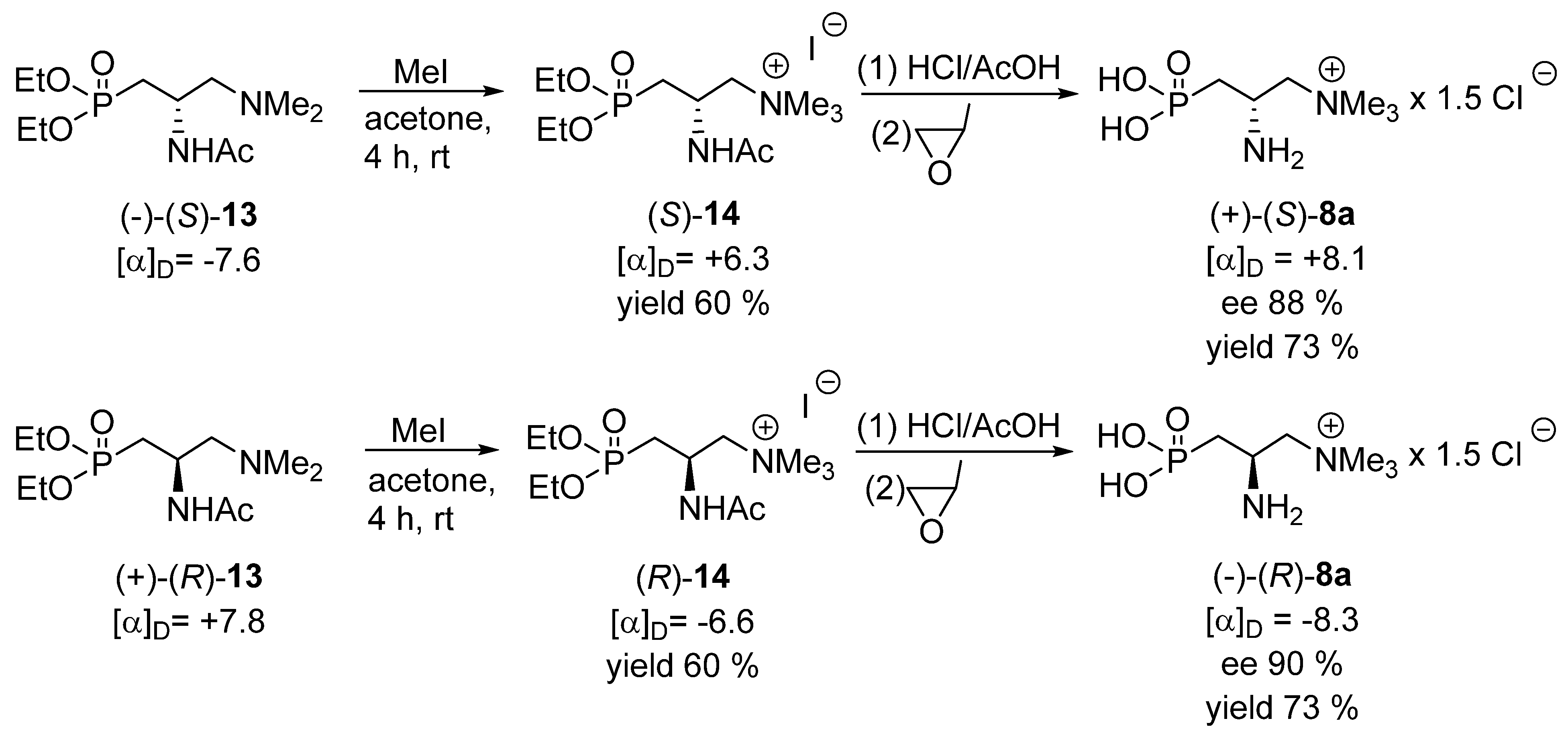Towards Chemoenzymatic Syntheses of Both Enantiomers of Phosphoemeriamine
Abstract
:1. Introduction
2. Results and Discussion
3. Experimental Section
3.1. General Information
3.2. Diethyl 2-Azido-3-N,N-dimethyloaminopropylphosphonate 11
- 1H NMR (CDCl3): δ = 1.29 (t, J = 7 Hz, 6H, CH3CH2); 1.38 ÷ 1.73 (m, 1H, CH2P); 1.83 ÷ 2.03 (m, 1H, CH2P); 2.23 (s, 6H, NMe2); 3.02 ÷ 3.18 (m, 1H, CHNMe2); 3.29 ÷ 3.48 (m, 2H, CH2N); 3.99 ÷ 4.13 (q, J = 7 Hz, 4H, CH3CH2).
- 31P NMR (CDCl3): δ = 30.1.
- HRMS (FAB) calcd for C9H22P1N4O3 (M + 1); 265.1429 found 265.1430.
3.3. Diethyl 2-Amino-3-N,N-dimethyloaminopropylphosphonate Rac-12
- 1H NMR (CDCl3): δ = 1.29 (t, J = 7 Hz, 6H, CH3CH2); 1.38 ÷ 1.55 (m, 1H, PCH); 1.76 ÷ 2.00 (m, 2H, CHP, NH2); 2.16 (s, 6H, N(CH3)2; 2.54 ÷ 2.60 (m, 1H, CHNH2); 2.78 ÷ 2.99 (m, 2H, CH2N); (q, 4H, CH3CH2).
- 31P NMR (CDCl3): δ = 31.7.
- 13C NMR (CDCl3): δ = 16.4, 21.1 (d, J = 137.7 Hz, PCH2); 39.6; 43.4; 61.4.
- HRMS (FAB) calcd for C9H24P1N2O3 (M + 1); 239.1525 found 239.15344.
3.4. N-(Diethoxyphosphoryl)methyl-(N′,N′-dimethylaminomethyl)acetamide (+)–(R)-13
- 1H NMR (CDCl3): δ = 1.31 (t, J = 7 Hz, 6H, CH3CH2); 1.40 ÷ 1.64 (m, 1H, CHP); 1.90 ÷ 2.10 (m, 1H, CHP); 1.95 (s, 3H, CH3O); 2.20 (s, 6H, NCH3)2); 2.83 ÷ 3.31 (m, 2H, CH2); 3.56 ÷ 3.70 (m, 1H, CH); 4.01 ÷ 4.15 (m, 4H, CH3CH2); 6.53 (bs, 1H, NHCO).
- 31P NMR (CDCl3): δ = 30.9.
- 13C NMR (CDCl3): δ = 16.3, 22.5 (d, J = 138.15 Hz, PCH2); 23.0; 39.6; 40.9; 52.7; 57.3; 61.8; 169.9 (CO).
- HRMS (FAB): calcd for C11H25P1N2O4 (M + 1); 281.1628 found 281.1630.
3.5. Kinetic Enzymatic Resolution of Diethyl 2-Amino-3-N,N-dimethylaminopropyl-phosphonate Rac-12
3.6. Trimethyl-(3-diethoxyphosphoryl-2-acetamido)propylammonium Iodide 14 (S or R)
- 1H NMR (D2O): δ = 1.27 (t, J = 7 Hz, 6H, CH3CH2); 1.96 (s, 3H, CH3CO); 2.60 ÷ 2.80 (m, 2H, PCH2); 3.11 (s, 9H, NCH3); 3.58 ÷ 3.82 (m, 3H, CH2CH); 4.13 (q, J = 7 Hz, 4H, CH3CH2).
- 31P NMR (D2O): δ = 26.7.
- 13C NMR (D2O): δ = 15.6; 22.0; 33.9 (d, J = 143.1 Hz); 39.0; 51.7; 64.2; 68.0; 174.7 (C=O).
- HRMS (FAB) calcd for C12H28P1N2O4 295.17924 found 295.1787.
3.7. 2-Amino-3-phosphoryl-1-trimethylammonium (Emeriamine) Sesquichloride 8a (R or S)
- 1H NMR (D2O): δ = 4.14 ÷ 4.00 (m, 1H, CHNH2), 3.90 ÷ 3.66 (m, 2H, CH2), 3.18 (s, 9H, (CH3)3N), 2.11 ÷ 1.97 (m, 2H, CH2P).
- 31P NMR (D2O): δ = 16.5.
- 13C NMR (D2O): δ = 66.4, 52.3, 41.9, 29.9 (d, JPC = 129.8 Hz, PCH2).
- HRMS: calcd for C6H18N2PO2 [M+] 197.1051 found 197.1055.
- Elemental analysis for C6H18Cl1.5N2O3P (250.37): calcd for C 28.81, H 7.26, N 11.21; found C 29.30, H 7.71, N 10.85.
4. Conclusions
Supplementary Materials
Author Contributions
Funding
Institutional Review Board Statement
Informed Consent Statement
Data Availability Statement
Conflicts of Interest
References
- Madalińska, L.; Kwiatkowska, M.; Cierpiał, T.; Kiełbasiński, P. Investigations on enzyme catalytic promiscuity: The First Attempts at a Hydrolytic Enzyme-promoted Conjugate Addition of Nucleophiles to α,β-unsaturated sulfinyl acceptors. J. Mol. Catal. B Enzym. 2012, 81, 25–30. [Google Scholar] [CrossRef]
- Lopez-Iglesias, M.; Gotor-Fernandez, V. Recent Advances in Biocatalytic Promiscuity: Hydrolase-catalyzed Reactions for Nonconventional Transformations. Chem. Rec. 2015, 15, 743–759. [Google Scholar] [CrossRef]
- Devamani, T.; Rauwerdink, A.M.; Lunzer, M.; Jones, B.J.; Mooney, J.L.; Tan, M.A.O.; Zhang, Z.-J.; Xu, J.-H.; Dean, A.M.; Kazlauskas, R.J. Catalytic Promiscuity of Ancestral Esterases and HydroxynitrileLyases. J. Am. Chem. Soc. 2016, 138, 1046–1056. [Google Scholar] [CrossRef]
- Dai, J.-R.; Sha, M.S.J.-T.; Zong, M.-H.; Li, N. Catalytic Promiscuity of Horseradish Peroxidase: Aerobic Oxidative Regeneration of Oxidized Nicotinamide Cofactors. ChemCatChem 2023, 15, e202300330. [Google Scholar] [CrossRef]
- Dutt, S.; Mohapatra, A.; Pandey, S.; Vikas Tyagi, V. A Decade Update on the Promiscuity of α-Amylase in Organic Synthesis. Tetrahedron 2024, 155, 133905. [Google Scholar] [CrossRef]
- De Luca, V.; Mandrich, L. Enzyme Promiscuous Activity: How to Define It and Its Evolutionary Aspects. Protein Peptide Lett. 2020, 27, 400–410. [Google Scholar] [CrossRef] [PubMed]
- Janicki, I.; Łyżwa, P.; Kiełbasiński, P. The First Enzyme-promoted Addition of Nitromethane to Imines (aza-Henry Reaction). Bioorg. Chem. 2020, 94, 103–377. [Google Scholar] [CrossRef] [PubMed]
- Fukuda, N.; Fukui, M.; Kai, Y.; Jayasooriya, A.P.; Sakono, M.; Maeda, H.; Ide, T.; Yamamoto, K. Effect of Emeriamine, an Inhibitor of Fatty Acid Oxidation, on Metabolic Fate of a Geometrical Isomer of Linoleic Acid in Perfused Rat Liver. J. Nutr. Sci. Vitaminol. 1998, 44, 525–535. [Google Scholar] [CrossRef] [PubMed]
- Shinagawa, S.; Kanamaru, T.; Harada, S.; Asai, M.; Okazaki, H. Chemistry of Emeriamine and its Analogs and Their Inhibitory Activity in Long-chain Fatty Acid Oxidation. J. Med. Chem. 1987, 30, 1458–1463. [Google Scholar] [CrossRef] [PubMed]
- Duan, R.-D.; Cheng, Y.; Erlanson-Albertsson, C. Effect of Emeriamine on Exocrine and Endocrine Pancreatic Function in Normal and Diabetic Rats. Scand. J. Clin. Lab. Investig. 1992, 52, 579–584. [Google Scholar] [CrossRef] [PubMed]
- Łyżwa, P.; Błaszczyk, J.; Sieroń, L.; Mikołajczyk, M. Asymmetric Synthesis of Structurally Diverse Aminophosphonic Acids by Using Enantiopure n-(p-Tolylsulfinyl)cinnamaldimines as Reagents. Eur. J. Org. Chem. 2013, 2013, 2106–2115. [Google Scholar] [CrossRef]
- Moskva, V.V.; Sitdikova, T.S.H.; Razumov, A.I.; Bondar, S.V. Condensation of Phosphorylaldehydes with p-Toluenesulfonamide. J. Gen. Chem. USSR 1979, 49, 415. [Google Scholar]
- Hall, M. Enzymatic Strategies for Asymmetric Synthesis. RSC Chem. Biol. 2021, 2, 958–989. [Google Scholar] [CrossRef] [PubMed]
- Matsuda, T. (Ed.) Future Directions in Biocatalysis, 2nd ed.; Elsevier: Amsterdam, The Netherlands, 2017; ISBN 978-0-444-63743-7. [Google Scholar]
- Faber, K. Biotransformations in Organic Chemistry, 7th ed.; Springer: Berlin/Heidelberg, Germany, 2018. [Google Scholar]
- Seddigi, Z.S.; Malik, M.S.; Ahmed, S.A.; Babalghith, A.O.; Kamal, A. Lipases in Asymmetric Transformations: Recent Advances in Classical Kinetic Resolution and Lipase–Metal Combinations for Dynamic Processes. Coord. Chem. Rev. 2017, 348, 54–70. [Google Scholar] [CrossRef]
- Mikołajczyk, M.; Łuczak, J.; Kiełbasiński, P. Chemoenzymatic Synthesis of Phosphocarnitine Enantiomers. J. Org. Chem. 2002, 67, 7872–7875. [Google Scholar] [CrossRef] [PubMed]
- Ryabov, B.V.; Ionin, B.I.; Petrov, A.A. 2,3 Epoxyphosphonates. Synthesis and Reactions with Nucleophiles. J. Gen. Chem. USSR 1988, 58, 859–871. [Google Scholar]
- Lima, R.N.; dos Anjos, C.S.; Orozco, E.V.M.; Porto AL, M. Versatility of Candida antarctica Lipase in the Amide Bond Formation Applied in Organic Synthesis and Biotechnological Processes. Mol. Catal. 2019, 466, 75–105. [Google Scholar] [CrossRef]
- Błaszczyk, J.; Kiełbasiński, P. Quarter of a Century after: A Glimpse at the Conformation and Mechanism of Candida Antarctica Lipase. Crystals 2020, 10, 404. [Google Scholar] [CrossRef]
- Sanfilippo, C.; Paternò, A.A.; Patti, A. Resolution of racemic amines via lipase-catalyzed benzoylation: Chemoenzymatic synthesis of the pharmacologically active isomers of labetalol. Mol. Catal. 2018, 449, 79–84. [Google Scholar] [CrossRef]
- Drabowicz, J.; Pokora-Sobczak, P.; Krasowska, D.; Czarnocki, Z. Optically Active t-Butylphenylphosphinothioic Acid: Synthesis, Selected Structural Studies and Applications as a Chiral Solvating Agent. Phosphorus Sulfur Silicon Relat. Elem. 2014, 189, 977–991. [Google Scholar] [CrossRef]
- Barretta, G.U.; Wenzel, T.J.; Balzano, F. Spectroscopic Analysis: NMR and Shift Reagents. In Reference Module in Chemistry, Molecular Sciences and Chemical Engineering; Elsevier: Amsterdam, The Netherlands, 2022. [Google Scholar] [CrossRef]






Disclaimer/Publisher’s Note: The statements, opinions and data contained in all publications are solely those of the individual author(s) and contributor(s) and not of MDPI and/or the editor(s). MDPI and/or the editor(s) disclaim responsibility for any injury to people or property resulting from any ideas, methods, instructions or products referred to in the content. |
© 2024 by the authors. Licensee MDPI, Basel, Switzerland. This article is an open access article distributed under the terms and conditions of the Creative Commons Attribution (CC BY) license (https://creativecommons.org/licenses/by/4.0/).
Share and Cite
Kiełbasiński, P.; Kwiatkowska, M.; Łyżwa, P.; Mikołajczyk, M. Towards Chemoenzymatic Syntheses of Both Enantiomers of Phosphoemeriamine. Molecules 2024, 29, 1799. https://doi.org/10.3390/molecules29081799
Kiełbasiński P, Kwiatkowska M, Łyżwa P, Mikołajczyk M. Towards Chemoenzymatic Syntheses of Both Enantiomers of Phosphoemeriamine. Molecules. 2024; 29(8):1799. https://doi.org/10.3390/molecules29081799
Chicago/Turabian StyleKiełbasiński, Piotr, Małgorzata Kwiatkowska, Piotr Łyżwa, and Marian Mikołajczyk. 2024. "Towards Chemoenzymatic Syntheses of Both Enantiomers of Phosphoemeriamine" Molecules 29, no. 8: 1799. https://doi.org/10.3390/molecules29081799
APA StyleKiełbasiński, P., Kwiatkowska, M., Łyżwa, P., & Mikołajczyk, M. (2024). Towards Chemoenzymatic Syntheses of Both Enantiomers of Phosphoemeriamine. Molecules, 29(8), 1799. https://doi.org/10.3390/molecules29081799







